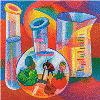Chemical and Biomolecular Engineering, Department of: Papers in Subdisciplines

Papers in Biotechnology
Use of Modified Chitosan Macrospheres in the Selective Removal of Immunoglobulins
Date of this Version
March 2006
Abstract
A solution of chtosan in acetic acid was atomized into sodium hydroxide solution to yield chitosan beads that were 400-600 pm in diameter and with a solids content of 3.5%. Chitosan beads were modified to include a spacer ann and end-capped with a carboxyethyl-group containing anionic ligand to generate a support for use in bioseparations. The ligand modified chitosan beads will be further referred to as LMCB. The influence of pH, salt concentration, and chaotropic salts on the binding of immunoglobulins (Igs) to LMCB has been studied. LMCB supports allowed the separation of monoclonal antibodies (Mab) from cell culture supernatants. In addition, different Mab sub-species (IgG,, IgG2, IgGZb. and IgG3) were also retained from cell culture supernatants rich in the same and further eluted to yield purified Mab. Elution was possible under mild conditions with a step salt gradient. Overall protein recoveries in the range of 90-95% were obtained with cell culture supernatant. Purity of products obtained form a single chromatographic step was estimated to be greater than 98%.


Comments
This is an electronic version of an article published in JOURNAL OF LIQUID CHROMATOGRAPHY & RELATED TECHNOLOGIES Vol. 27, NO. 17, pp. 2649-2669,2004. JOURNAL OF LIQUID CHROMATOGRAPHY & RELATED TECHNOLOGIES is available online at: http://journalsonline.tandf.co.uk/ DOI: 10.108 1IJLC-200029 11 1 1082-6076 (Print); 520-572X (Online) Copyright © 2004 by Marcel Dekker, Inc.